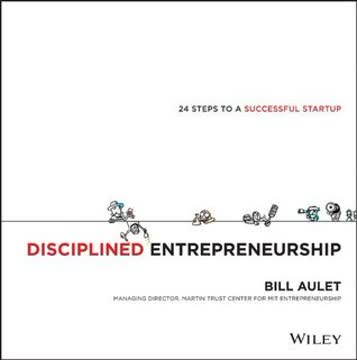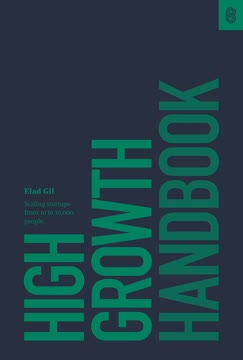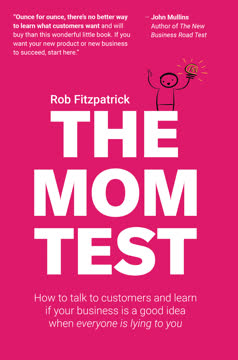Key Takeaways
1. Build a strong foundation: Start small and focus on product-market fit
Starting a company is hard. There are long hours, constant fear of failing, many rejections, etc.
Start with a co-founder. Having a partner to share the emotional burden of starting a company is crucial. While solo founders often experience burnout, co-founders can support each other through the challenges. However, avoid 50/50 partnerships to ensure clear decision-making.
Keep the team small. Until product-market fit is achieved, limit the team to six or fewer people. This allows for:
- Easier communication and coordination
- Flexibility to adapt to customer feedback
- Efficient prototype development
- Focused problem-solving
Define product-market fit. For B2B companies, aim for at least $1 million in annual recurring revenue (ARR) before considering scaling. Ensure customers are not only buying but also renewing and recommending your product.
2. Cultivate essential individual habits for productivity and growth
When you say it twice, write it down.
Implement GTD (Getting Things Done). Organize tasks into:
- Next Actions
- Waiting For
- Someday/Maybe
- Agenda
- Projects
Use a tool like Evernote or Omnifocus to manage these lists effectively.
Practice Inbox Zero. Clear your inbox twice daily by:
- Addressing emails that take less than two minutes immediately
- Creating Next Actions for longer tasks
- Filing emails into appropriate categories
Focus on your Top Goal. Schedule two hours each day to work on your most important objective. This practice ensures progress on critical tasks amidst daily distractions.
3. Foster effective group habits and transparent communication
There must be consequences for breaking agreements.
Create Impeccable Agreements. Ensure all agreements are:
- Precisely defined
- Fully agreed upon by all relevant parties
- Written down when possible
Hold team members accountable for these agreements, with clear consequences for breaking them.
Embrace transparency. Share both positive and negative information with your team. This builds trust and enables team members to contribute their skills and knowledge effectively.
Implement conflict resolution techniques. Use the following steps:
- Have each person write down their deepest thoughts about the other
- Share and acknowledge these thoughts
- Create action items to address issues
- Follow up to ensure completion of action items
4. Implement robust infrastructure and collaboration systems
A well-run company documents every aspect of its operations, so that its team members can easily step into a new role when needed.
Develop a comprehensive folder system and wiki. Create:
- Department-specific folders
- A central wiki linking to important documents
- Onboarding materials for new hires
Establish Areas of Responsibility (AORs). Assign each function to a single person to prevent the "tragedy of the commons" and ensure accountability.
Track Key Performance Indicators (KPIs). Identify 5-6 significant metrics for each major function and make them easily visible to the entire company.
Implement a goal-tracking system. Use tools like Asana, Trello, or Betterworks to track progress on company, department, and individual goals.
5. Master the art of meetings and feedback for organizational success
Frequent, transparent feedback is critical for building a strong culture and a thriving business.
Structure effective meetings. Implement:
- One-on-One meetings for individual accountability and coaching
- Team meetings for group accountability and issue resolution
- Company-wide meetings for transparent communication
- Quarterly offsites for retrospectives and planning
Foster a culture of feedback. Encourage:
- Asking for feedback
- Acknowledging and appreciating feedback
- Acting on feedback
Use the "Like and Wish That" format for giving feedback to create a positive and constructive environment.
6. Develop efficient processes for fundraising, recruiting, and sales
The introduction is a key part of the fundraising process, and you only get one chance at it.
Fundraising: Use the Triangulation Method to secure introductions to investors. Build relationships before pitching your company.
Recruiting: Follow the "Who" method:
- Create a detailed scorecard for each position
- Source candidates continuously
- Conduct structured interviews
- Sell the opportunity to top candidates
Sales: Focus on:
- Building trust with potential customers
- Identifying specific customer pain points
- Selling results, not features
Develop a sales team structure with Qualifiers, Closers, and Farmers to optimize the sales process.
7. Embrace conscious leadership and customer obsession
Conscious Leadership is about being more interested in learning than being right.
Practice Conscious Leadership. Shift from defensiveness to curiosity by:
- Recognizing emotional triggers
- Releasing negative emotions
- Remaining open to new ideas
Cultivate customer obsession. Regularly:
- Sit with customers to understand their problems
- Observe their daily routines
- Gather feedback from customer support and sales teams
Ensure this customer-centric mindset permeates all departments, especially engineering.
8. Navigate the challenges of scaling and organizational structure
Re-orgs, like terminations, are always disruptive and cause people angst, even if the logic for them is glaringly obvious.
Implement a formal management system. As the company grows beyond 15-20 people, establish:
- Clear reporting structures
- Regular communication channels
- Performance tracking mechanisms
Handle re-organizations carefully. When restructuring:
- Consult department heads beforehand
- Announce changes company-wide
- Provide detailed explanations and Q&A sessions
- Allow time for the organization to adapt between changes
Address the technical founder's transition. For technical CEOs:
- Gradually delegate engineering responsibilities
- Focus on building trust in the engineering team
- Embrace and learn to love company building
- Consider hiring a partner to handle go-to-market strategies
Last updated:
FAQ
What's "The Great CEO Within" about?
- Comprehensive Guide: "The Great CEO Within" by Matt Mochary is a tactical guide for building a successful company from the ground up, aimed at both new and experienced CEOs.
- Structured Approach: The book is organized into eight sections, covering everything from starting a company to individual and group habits, infrastructure, collaboration, processes, and other departments.
- Practical Solutions: It provides practical solutions and frameworks for common challenges faced by CEOs, with a focus on efficiency and effectiveness.
- Breadth and Depth: The book offers both high-level overviews and detailed processes, making it a comprehensive resource for company building.
Why should I read "The Great CEO Within"?
- Proven Strategies: The book is based on the author's experience coaching successful tech CEOs, offering strategies that have been tested and proven in real-world scenarios.
- Time-Saving: It condenses essential knowledge and practices into a single resource, saving time for busy CEOs who need to learn quickly.
- Holistic Approach: Covers a wide range of topics, from personal productivity to company culture, ensuring a well-rounded understanding of what it takes to be a successful CEO.
- Actionable Advice: Provides specific, actionable advice that can be immediately implemented to improve both personal and organizational performance.
What are the key takeaways of "The Great CEO Within"?
- Individual and Group Habits: Emphasizes the importance of developing effective personal and group habits to enhance productivity and collaboration.
- Infrastructure and Processes: Highlights the need for robust infrastructure and processes to support company growth and prevent single points of failure.
- Customer Obsession and Culture: Stresses the importance of being customer-focused and building a strong company culture to drive success.
- Decision-Making and Transparency: Encourages transparent decision-making processes and clear communication to foster trust and efficiency within the organization.
How does Matt Mochary define Product-Market Fit in "The Great CEO Within"?
- Customer Value: Product-Market Fit is achieved when customers find so much value in a product that they are willing to buy it and recommend it to others.
- Metrics: Key indicators include revenue, renewal rates, and Net Promoter Score (NPS), which reflect customer satisfaction and loyalty.
- Enterprise Customers: For B2B companies, long-term contracts, rather than initial test purchases, are a true indication of Product-Market Fit.
- Revenue Benchmark: For enterprise companies, achieving greater than $1 million in annual recurring revenue is a benchmark for Product-Market Fit.
What is the "Top Goal" framework in "The Great CEO Within"?
- Daily Focus: The Top Goal framework involves scheduling two hours each day to work solely on your top priority goal, ensuring progress on long-term objectives.
- Early in the Day: It's recommended to schedule this time early in the day to avoid distractions and take advantage of peak mental energy.
- Avoid Interruptions: During this time, avoid responding to emails, texts, and calls to maintain focus and productivity.
- Gradual Implementation: For those new to focused work time, start with 30 minutes and gradually increase to two hours as you build the habit.
How does "The Great CEO Within" suggest handling conflict resolution?
- Feeling Heard: The book emphasizes the importance of ensuring all parties feel heard, which can be achieved by summarizing and repeating back what the other person has said.
- Written Method: Recommends using a written method for conflict resolution, which is more efficient and ensures clear communication and understanding.
- Structured Process: Involves writing down feelings of anger, fear, sadness, joy, and excitement, and sharing these with the other party to foster understanding.
- Action Items: Co-create a plan with specific action items to prevent future misunderstandings and improve the relationship.
What is the "Energy Audit" in "The Great CEO Within"?
- Maximize Energy: The Energy Audit is a process to identify activities that energize or drain you, aiming to spend 75-80% of your time on energizing tasks.
- Color-Coding: Use two colors to highlight activities in your calendar—green for energizing and red for draining—to identify patterns.
- Outsource or Eliminate: Find ways to outsource or eliminate red activities to focus more on your Zone of Genius.
- Monthly Review: Conduct the Energy Audit monthly to ensure continuous improvement in energy management.
What does "The Great CEO Within" say about building a strong company culture?
- Values: Establish clear company values that guide decision-making and hiring, ensuring alignment with the company's mission and goals.
- Fun and Celebration: Incorporate fun and celebration into the company culture to boost morale and foster a positive work environment.
- Cross-Team Communication: Encourage cross-team communication to prevent silos and promote collaboration across departments.
- Avoid Politics: Implement policies to prevent lobbying and politics, which can be detrimental to company culture and productivity.
How does "The Great CEO Within" recommend structuring meetings?
- ACT Framework: Meetings should focus on Accountability, Coaching, and Transparency to ensure effective communication and progress tracking.
- Regular Cadence: Establish a regular schedule for one-on-one, team, and company-wide meetings to maintain consistent information flow.
- Written Preparation: Require written updates and issues before meetings to increase efficiency and ensure all voices are heard.
- Time-Boxing: Time-box agenda items to keep meetings focused and productive, using the RAPID framework for decision-making when needed.
What is the RAPID decision-making process in "The Great CEO Within"?
- Roles Defined: RAPID stands for Recommend, Agree, Perform, Input, and Decide, with each role clearly defined to streamline decision-making.
- Efficient Meetings: The process is designed to make fully-informed decisions quickly, especially when consensus cannot be reached.
- Type 1 vs. Type 2: Distinguishes between irreversible (Type 1) and reversible (Type 2) decisions, with Type 2 decisions made quickly by individuals or small groups.
- Documentation: Requires written documentation of issues and proposed solutions to facilitate informed and efficient decision-making.
What are the best quotes from "The Great CEO Within" and what do they mean?
- "Becoming a great CEO requires training." This highlights the importance of continuous learning and development for CEOs to effectively lead their companies.
- "When you say it twice, write it down." Emphasizes the value of documentation to improve communication and reduce repetitive explanations.
- "Life and company-building don’t have to be hard or painful." Encourages a mindset of gratitude and appreciation to foster a positive and fulfilling work environment.
- "The first goal of the company should be to achieve real Product-Market Fit." Stresses the importance of focusing on Product-Market Fit before scaling to ensure long-term success.
How does "The Great CEO Within" address the challenge of scaling a company?
- Formal Management System: Implement a formal management system to maintain productivity and communication as the company grows beyond 20 employees.
- Infrastructure and Processes: Develop robust infrastructure and processes to support scaling, including goal-tracking systems and Areas of Responsibility (AORs).
- Avoid Early Growth: Warns against growing too early before achieving Product-Market Fit, as it can lead to inefficiencies and potential failure.
- Blitz Scaling: Once Product-Market Fit is achieved, focus on blitz scaling to capture market share, supported by a strong team and management system.
Review Summary
The Great CEO Within receives high praise for its practical, concise advice on running a tech startup. Readers appreciate its tactical approach, covering topics from personal productivity to company processes. Many found it invaluable for first-time founders, distilling wisdom from multiple sources. Some criticize its focus on VC-backed startups and lack of depth in certain areas. Overall, it's widely recommended for its actionable insights, with readers often planning to revisit it. The book's format as a shareable Google Doc was noted as innovative and fitting for its startup audience.
Similar Books










Download PDF
Download EPUB
.epub digital book format is ideal for reading ebooks on phones, tablets, and e-readers.




